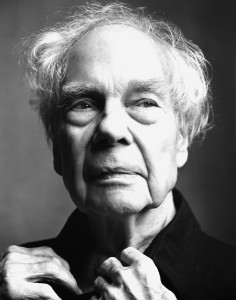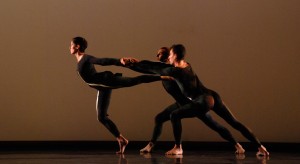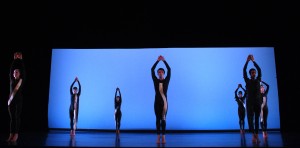The Merce Cunningham Dance Company completed another lap in the countdown of its Legacy Tour toward the end of this year when it will give its final performances in New York City. The last work Cunningham choreographed for his company, Nearly Ninety2, was given a single performance to a packed house at Stanford University’s Memorial Auditorium on November 1, 2011. Cunningham (who died in 2009 at the age of 90) seems in this work to have prefigured his own passing but the initially somber mood made of exceedingly slow movement progresses subtly toward a sense of quickening and light until it can practically no longer be contained on the stage. The idea of this piece as a choreographic farewell is rendered more poignant by the decision of the Cunningham Trust to terminate the company after its world tour in able to devote attention to teaching and licensing his work to other companies. This strategy to ensure the survival of his work on the stage is the first of its kind in the modern dance field. The audience was very aware it was seeing his last work for the last time: last squared, as it were. Even the Merce Cunningham Dance Foundation archive, presently housed at Westbeth in New York City, will be ‘disbanded’ when its holdings are donated to the Dance Collection of the New York Public Library. As explained by archivist David Vaughan in a post-performance discussion, the final activity of the Foundation is the creation of ‘dance capsules’ containing all the information necessary to reconstruct his works. In some sense, Nearly Ninety2 was itself a living and breathing dance capsule.

The double sense of an ending – a last work performed for the last time by the choreographer’s company – invested this performance with a sense of finality, and was dramatic and affecting as a memorializing gesture. Yet, Nearly Ninety2 was actually ‘reconstructed’ for this final performance from the original, which suggests a certain encapsulation of memory at work even prior to the dissolving of the Company. Nearly Ninety2 was apparently something quite different at its premiere at BAM in 2009. In the 2011 staging there was no eight-ton set center stage concealing the musicians, and on top of which a solo was performed: only a bare stage filled with the comings and goings of thirteen dancers in newly designed costumes. It was a version of late Cunningham as purist and suggests the trope of the artist who, at an advanced age, had the distinct ability to distill the essence of his art in an ascetic gesture – one thinks of Johann Sebastian Bach’s cycle Art of the Fugue, completed as he was dying, and whose score was in need of being sorted out posthumously.

I had been struck once once before at the Company’s memorial concert (Park Avenue Armory, New York City, October 28, 2009) at how, despite the chance procedures Cunningham was known for using in the compositional process, he nevertheless remained accountable for (if not intentionally responsible to) each pairing of bodies, each angle from which shapes emerged out of movement, in sum, for each visual and kinesthetic moment of his work as it was set before us. Despite its openness of meaning and continuous experimentation and discovery Cunningham’s work displayed a deliberate quality as well. In a time when improvisation and new collaborative techniques for setting dances abound he sustained a sense of choreographic craftsmanship that is becoming a rarity in the contemporary dance scene. This would be particularly true of Nearly Ninety2 in that here, as director of choreography Robert Swinston explained in the post-performance discussion, Cunningham did not use computer software in making this dance. Nearly Ninety2 shows a hands-on commitment to the creation of choreography, which displays Cunningham’s mastery of theme and variation at multiple levels of the choreographic construction.

The importance of lighting and the subtle evolution of the sound score by John Paul Jones and Takehisa Kosugi make it a chromatic piece that begins in a somber darkness peopled by dancers in grey leotards against a black backdrop as they enter couple by couple: the women perform beguilingly smooth double or triple attitude turns and then proceed to hunched over développés devant in plié, as the men arch with one hand to head and perform the duties of partnering in an almost balletic sense. The couples accumulate and the sense of how the shapes change occurs as much through canon as through the sheer accumulation of bodies. The play of mass and line (both in the individual and the group) is the watchword, as well as a certain structural counterpoint: the work begins with a remarkably sustained slowness and somberness – balances and supports extended so long that the dancers fairly droop from the pull of gravity. Once the back scrim lifts to reveal a searing crack of yellow light spilling over the floor the ambiance has begun to change through imperceptible degrees (possibly a metaphor for time itself). Such gradual but still stark changes of light are a constant, and make the dancers stand forth as if they were insects displayed on glass as the work progresses from an almost melancholy slowness to progressively paced attack and speed until they virtually fly off the stage at the end to an incandescent dawn.